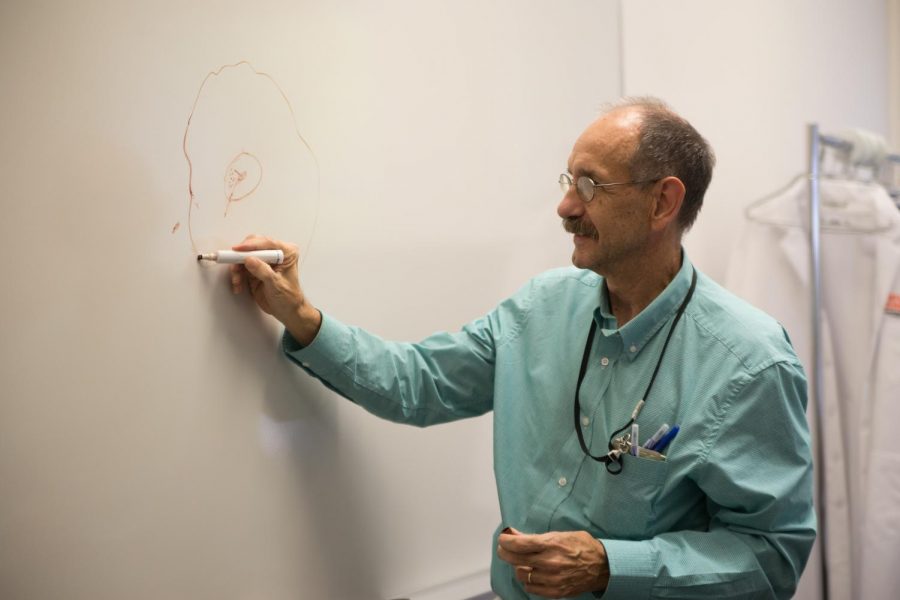College of Veterinary Medicine researches effects of nontuberculous mycobacteria on host cells
October 16, 2017
Researchers aim to utilize new protein channel information to further medical therapies.
New research has been produced out of the College of Veterinary Medicine concerning how nontuberculous mycobacteria infect their host cells. Nontuberculous mycobacteria are commonly found in the environment.
Dr. Luiz Bermudez, head of the department of biomedical sciences, and Lia Danelishvili, assistant professor, are the lead researchers in the mycobacterial field and co-authors of the new paper published by the Nature Publishing Group. The Voltage-Dependent Anion Channels (VDAC) of mycobacterium avium phagosome are associated with bacterial survival and lipid export in macrophages.
The research for this paper focuses on the nontuberculous mycobacterium that is the leading causative of infection in patients with HIV/AIDS as well as in individuals with chronic lung conditions such as Cystic Fibrosis. They found that the nontuberculous mycobacteria organisms block a number of cell functions and spread through the body via nontraditional strategies.
According to Bermudez, bacteria and viruses block cell functions in order to exploit the host for shelter and nutrients. The research in regards to this focuses on how bacteria and viruses survive and replicate in unfriendly environments where they’re most likely under attack from the immune system.
“We try to understand how the pathogens, the ones that cause disease, are capable of doing that,” Bermudez said. “That’s very important because if we didn’t have an immune system, we wouldn’t be here.”
Patients with compromised immune systems, as well as various lung diseases, are particularly susceptible to infection, according to Bermudez. However, globally, tuberculous mycobacterium present a different problem.
“If you look worldwide, tuberculosis is the most common. But in the United States it is not. In several other countries, like Japan, it is not,” Bermudez said. “These other bacteria, such as avium, are more common, they do happen. Bronchitis, emphysema, other chronic lung diseases, they are common in developed countries. You can find the infection in this population of individuals, for example, in Oregon.”
According to Dr. Danelishvili, mycobacteria are unusual compared to other bacteria because it has no external way to transport pathogenic materials into the host cells
“It has no use of traditional methods seen in other microorganisms such as pili, a syringe-like structure that some bacteria can utilize to inject and transfer materials into the host cells,” Dr. Danelishvili said. “The research question then became about how exactly the mycobacterial pathogens can infect its host cell and survive in the hostile environment.”
The mycobacterial pathogens are very successful organisms that learned how to block natural killing processes of the immune cells such as lower cell pH, autophagy or programmed cell death known as apoptosis, according to Dr. Danelishvili.
In order to understand the infection patterns of mycobacterium, researchers viewed the situation from an unorthodox way, according to Danelishvili. The research method approached mycobacteria’s unique infection pattern from the host organism, rather than from the pathogenic organism.
“The idea was that we started to look from the host point of view to see what are the host molecules that surround bacteria as an envelope called phagosome and then find if mycobacteria could be using those molecules to its benefit to transport pathogenic material,” Danelishvili said.
According to Bermudez, the pathogen attaches to a phagosome’s voltage-dependent anion channel, a protein transport channel. There, it can secrete pathogenic materials such as lipids, which float until the channel opens.
“The microorganism has a way to make sure every single protein they release will go through that door,” Bermudez said. “How they do it? Microorganisms kind of dock in the protein channel and when they secrete a protein it goes through the channel.”
The nontuberculosis mycobacterium’s lipids or proteins that are secreted are then guaranteed to enter the cell’s cytosol in question when the channel opens to let in other molecules, according to Bermudez.
“Mycobacteria manipulates those mechanisms by secreting those proteins or sending lipids, or in some cases, DNA inside the host cell to change the outcome and survive,” Bermudez said.
Bermudez says that another aspect of research in the lab is to develop and collaborate on new treatments for this bacterial infection.
Sasha Rose, an assistant professor in the college of Veterinary Medicine at OSU, works on developing and collaborating on new nontuberculous mycobacterial therapies.
“Down the line, we’re trying to figure out ways to make new therapies smarter by customizing them and refining the targets involved,” said Rose.
Rose works with others in the industry towards goals of developing more effective ways to treat nontuberculous mycobacterial infections.
“We can decorate these new drug therapies with antagonists or molecules, making them more specific to what they’re going after,” Rose said.
Through their research for this paper, authors found that the mycobacteria bind to the host channels on the envelop and export bacterial lipids into the cytosol of the cell. Current research being done is an extension of this paper towards virulence proteins that could be excreted in a similar mechanism.
“We teamed up with bioengineering research group here at OSU, and would like to assemble an artificial membrane,” Dr. Danelishvili said. “We hope to insert those channels and then study bacterial molecule export in the in vitro system because cells are very complex, and those channel proteins do not exist just on the phagosome.”
The understanding how exactly mycobacteria secrete pathogenic material into the cell cytosol will assist in coming up with novel methods to block the host phagosome transport systems and bacterial transporters for therapeutic purposes.
“We would like to extract and simplify the method. Assembling the membrane, inserting the channels and testing whether the membrane will help us identify whether proteins are exported through the same channel as well. Maybe some other mechanism,” Danelishvilli said.











































































































